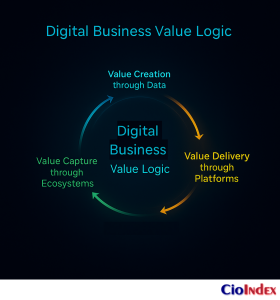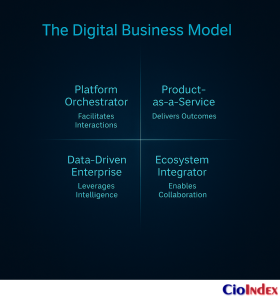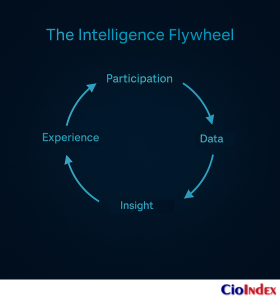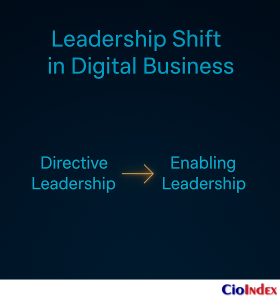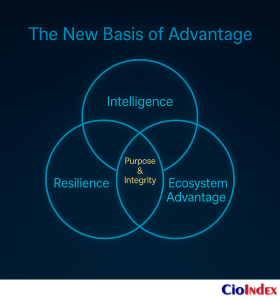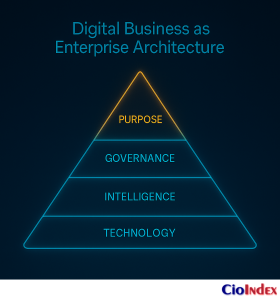The Question That Defines the Modern Enterprise
A new kind of enterprise has begun to take shape — one built not on products, processes, or physical scale, but on intelligence, connection, and continuous creation. This is the digital business: a form of organization in which technology and strategy are no longer separate languages but the same vocabulary of value.
Beneath that vocabulary lies a deeper transformation — a new logic of the enterprise itself. Digital business replaces the mechanics of control with the dynamics of learning. It operates as a system of intelligence in which data, design, and decision-making form an integrated whole.
The modern enterprise no longer seeks stability through structure but coherence through adaptability. Its advantage arises from how quickly it learns, how deeply it connects, and how clearly it aligns purpose with performance. In traditional enterprises, efficiency was the measure of success; in digital business, learning is. Decisions are made at the edge, informed by data that moves freely across the organization. Products evolve through feedback loops. Platforms connect customers, partners, and creators into living systems that expand in value with every interaction. This is the architecture of digital business — a logic that unites technology, governance, and culture into a living system capable of renewal.
This structure changes the very idea of advantage. Scale alone no longer guarantees endurance; intelligence does. The enterprises that lead are those able to sense shifts in their environment and translate them into action before others can interpret them. They compete not through possession but through participation — orchestrating networks that multiply capability far beyond the boundaries of the firm.
Such organizations operate with a new economic logic.
- Value is created through data — the ability to extract insight and foresight from information.
- Value is delivered through platforms — digital architectures that connect ecosystems of demand and supply.
- Value is captured through collaboration — shared innovation and co-creation replacing linear transactions.
These principles define the architecture of the digital enterprise. They call for leadership that sees technology as a strategic instrument of purpose, not merely of productivity. Governance must evolve from managing resources to shaping relationships — among systems, partners, and people.
Digital business therefore represents more than a shift in tools or models; it signals a new philosophy of enterprise design. It is adaptive by nature, transparent by structure, and ethical by necessity. Its measure is not the speed of adoption but the depth of alignment between technology, intelligence, and intent.
Understanding this form of organization is essential because it is no longer emerging — it is here. The following sections examine its foundations, dimensions, and implications for strategy, leadership, and governance, establishing digital business as the defining construct of the modern economy.
What Is Digital Business? (Definition and Dimensions)
Digital business is often described in the language of technology, but its essence is strategic. It is not defined by the tools it employs, but by the logic through which it creates and sustains value. A digital business is an enterprise that uses data, connectivity, and intelligence as the primary means of generating advantage. Technology is not its support system — it is its operating fabric.
At its core, digital business integrates three interdependent capabilities:
- the ability to convert data into insight,
- the ability to translate insight into action, and
- the ability to turn action into continuous learning.
This cycle — data, action, learning — is the foundation of modern value creation. It replaces the linear models of industrial enterprise with systems that evolve through feedback and intelligence. Where the factory once symbolized production, the platform now symbolizes creation: a space where value is generated through participation, interaction, and exchange.
Defining Digital Business
A digital business can be defined as an organization that creates, delivers, and captures value primarily through digital capabilities, platforms, and ecosystems. It operates as an adaptive system — one capable of sensing its environment, learning from it, and responding in real time.
This definition carries several implications:
- Value is information-rich. Data becomes a productive asset, shaping every decision and experience.
- Boundaries are permeable. Partnerships, platforms, and ecosystems extend the enterprise far beyond its walls.
- Change is constant. Strategy is iterative, built on sensing and adaptation rather than prediction and control.
Unlike digital transformation, which equips the organization with these capabilities, digital business institutionalizes them. It is not an initiative but a steady state — the natural operating condition of enterprises that have fully internalized the digital economy’s logic.
Traditional Business vs. Digital Business
| Dimension | Traditional Business | Digital Business |
| Value Logic | Creates and delivers value through products and transactions. | Creates, delivers, and sustains value through data, platforms, and participation. |
| Business Model | Linear — value flows from producer to consumer. | Networked — value emerges from interaction among participants. |
| Structure | Hierarchical, function-driven, optimized for control. | Distributed, capability-driven, optimized for learning and adaptation. |
| Decision Basis | Experience and prediction guide strategy. | Data and feedback guide continuous sense–respond cycles. |
| Scale Logic | Expansion of assets and capacity drives growth. | Expansion of intelligence and ecosystems drives growth. |
| Customer Relationship | Transactional — customers as recipients of value. | Relational — customers as co-creators of value. |
| Innovation Approach | Periodic and centrally managed. | Continuous and ecosystem-enabled. |
| Governance Focus | Compliance and operational stability. | Ethics, transparency, and adaptive accountability. |
| Performance Definition | Efficiency and output. | Learning, engagement, and resilience. |
| Source of Advantage | Cost leadership, efficiency, and market share. | Insight, agility, and network effects. |
| Technology Role | Support function — automates existing processes. | Strategic fabric — defines how value is created and delivered. |
| Cultural Orientation | Predictable, risk-averse, internally focused. | Curious, experimental, outwardly connected. |
The Dimensions of Digital Business
Digital business rests on four structural dimensions, each representing a shift in how value is conceived and realized.
1. Business Model Innovation
Digital businesses reimagine how value is generated and monetized. Products evolve into services; services become platforms; platforms grow into ecosystems. Revenue flows increasingly depend on data, algorithms, and participation. The focus moves from ownership to access, from transactions to relationships, from one-time exchanges to continuous engagement.
2. Customer Experience
Experience becomes the principal form of differentiation. Every interaction generates data; every data point refines the next interaction. Digital enterprises treat customers not as endpoints of a transaction but as co-creators of value. Personalization, context awareness, and immediacy define competitive strength.
3. Operational Intelligence
Operations shift from efficiency to intelligence. Processes are instrumented, automated, and connected. Decisions occur closer to the source of data. Predictive systems anticipate disruption; adaptive workflows self-correct. The organization becomes a learning organism — one that improves with every interaction.
4. Ecosystem Integration
No digital business operates alone. Value is distributed across partners, developers, suppliers, and even competitors. Platforms orchestrate this collaboration, enabling shared growth and resilience. Ecosystem thinking replaces linear value chains with dynamic value networks, where every participant adds and extracts value simultaneously.
These dimensions together form the architecture of digital business. Each depends on the others: customer experience is enriched by operational intelligence; ecosystem integration expands the reach of business models; and data circulates through them all as the connective tissue of value.
A Shift in Organizational Logic
The rise of digital business signals a deeper structural shift. Enterprises once designed for stability now design for motion. Governance evolves from supervision to orchestration, leadership from authority to enablement. Success depends less on the ability to plan and more on the ability to learn.
Digital business, therefore, is not simply a new competitive posture — it is a new logic of enterprise. It aligns technology, strategy, and culture into a single system of continuous value creation. In this system, every process learns, every interaction teaches, and every decision contributes to an expanding circle of intelligence.
The Evolution: From E-Business to Digital Enterprise
The rise of digital business did not begin with a single breakthrough. It emerged through a series of evolutions — each expanding what technology could enable and what organizations could imagine. From the early experiments of e-commerce to the platform-driven ecosystems of today, every phase has deepened the integration of technology, data, and human intent into the structure of enterprise.
From Automation to Integration
The first digital shift focused on automation. Organizations applied technology to improve efficiency — streamlining workflows, reducing costs, and digitizing routine processes. The aim was operational consistency, not reinvention. These early systems connected departments but rarely redefined the business itself.
As networks expanded, the concept of e-business emerged. In the late 1990s and early 2000s, enterprises began conducting transactions online, building digital storefronts, and extending supply chains through web connectivity. The innovation was transactional: moving commerce to digital channels while traditional structures remained largely intact.
This period established the foundation of digital interaction but not yet digital intelligence. Data was abundant but fragmented; strategy remained product-centric; governance operated in silos. The enterprise was still an industrial construct augmented by technology, not shaped by it.
From Connectivity to Intelligence
The second evolution was driven by connectivity and analytics. As cloud computing, mobile technology, and data integration matured, organizations gained the ability to sense and respond in near real time. The internet ceased to be a channel and became the connective tissue of the business.
Companies like Amazon and Tencent pioneered models where every digital interaction produced feedback — information that improved operations, sharpened personalization, and accelerated innovation. Data ceased to be an exhaust of activity and became its raw material.
This stage introduced the first signs of intelligent enterprise design. Strategy and technology converged; decisions were informed by insight rather than intuition. The organization began to learn.
From Digital Transformation to Digital Enterprise
The current stage — digital enterprise — extends far beyond modernization. It integrates digital capabilities into the core logic of value creation. Processes, platforms, and partnerships form an adaptive system that continuously evolves in response to its environment.
Unlike the e-business era, where technology supported transactions, digital enterprise architectures organize around information flows and learning loops. They are designed for sensing, predicting, and adapting — not for executing predefined routines.
Global leaders in sectors as diverse as finance, manufacturing, and logistics illustrate this maturity. DBS Bank, for example, redefined itself from a traditional financial institution into a technology company with a banking license. Its core systems operate through APIs and analytics that personalize experiences for millions of customers while maintaining the regulatory and ethical rigor of its domain. Similarly, Siemens’ digital industries strategy fuses industrial engineering with digital intelligence, creating self-optimizing production systems that learn from every cycle.
In both cases, the transformation is structural: digital capability becomes the framework through which strategy, culture, and operations cohere. These are not technology projects; they are new forms of enterprise architecture.
The Defining Characteristics of the Digital Enterprise
Three characteristics distinguish the digital enterprise from its predecessors:
- Learning as Structure. Continuous feedback informs every decision. The enterprise evolves through intelligence, not directives.
- Fluid Boundaries. Ecosystems replace linear value chains. Partners, customers, and even competitors co-create value in shared networks.
- Purpose as Alignment. Technology operates in service of strategy and values. Ethical design and responsible data use become intrinsic to performance.
These characteristics mark the arrival of a new economic form. The enterprise becomes less a collection of assets and more a system of intelligence — one that integrates people, platforms, and data into a living model of creation and renewal.
Digital business, in this sense, is not the latest stage of progress but the first model of permanence in the digital economy — an organization designed to change continuously without losing its coherence or purpose.
The Digital Business Model
Every era of enterprise has been defined by a dominant business model — a logic that connects how value is created, delivered, and captured. In the industrial age, that logic was linear: inputs became outputs through a controlled sequence of production and distribution. In the digital economy, the logic is systemic: value emerges from interaction, information, and iteration.
A digital business model transforms the organization from a producer of goods and services into an orchestrator of intelligence and experience. It replaces the traditional flow of value from company to customer with a network of exchanges where every participant — user, partner, platform, algorithm — contributes to creation and growth.
The defining question shifts from What do we sell? to How do we enable value to occur?
The Structure of Digital Value Creation
Digital business models rest on three structural elements:
- Data as Capital. Information functions as an economic resource, accumulated, refined, and deployed for strategic advantage. Every interaction generates data, and every data point improves future performance.
- Platforms as Infrastructure. Platforms serve as the architecture through which interactions occur — connecting producers and consumers, partners and developers, devices and services. They create scale through participation, not possession.
- Ecosystems as Context. No digital business exists in isolation. Value depends on networks of collaboration — shared data, APIs, and standards that allow multiple actors to innovate together.
This architecture allows digital businesses to grow without linear increases in cost. Scale becomes exponential, not proportional. Learning compounds value over time, producing what economists call increasing returns to intelligence.
Four Archetypes of Digital Business Models
While each organization expresses these principles differently, most digital enterprises align with one or more of four archetypes — distinct configurations of how they generate and sustain value.
1. The Platform Orchestrator
Platforms create the conditions for value to emerge through interaction. They connect supply and demand, manage trust between participants, and continuously evolve based on user behavior.
Companies like Airbnb, Apple, and Shopify exemplify this model. Their success lies not in producing inventory but in structuring engagement — defining the rules, data flows, and experiences that allow others to create value on their platforms. The platform orchestrator wins through network effects: the more participation it enables, the more valuable it becomes.
2. The Product-as-a-Service Provider
This model converts ownership into access. Products become services, generating continuous relationships instead of discrete sales.
Rolls-Royce’s “Power by the Hour” initiative redefined jet engines as performance services rather than equipment. Digital monitoring allows the company to guarantee uptime, predict maintenance, and align pricing with customer outcomes.
In this model, the product is no longer the endpoint of value — it is a living contract, continuously informed by data.
3. The Data-Driven Enterprise
Some organizations build advantage directly from intelligence. Their business models revolve around data collection, analytics, and predictive capability. Netflix, for example, uses behavioral data not only to recommend content but to guide production decisions — transforming insight into creative strategy. Similarly, Tesla’s vehicles continuously generate driving data that refine algorithms, enhance safety, and inform product design. In both cases, learning itself becomes the product.
4. The Ecosystem Integrator
The integrator coordinates networks of value across industries. It connects complementary partners to deliver unified experiences.
Amazon Web Services illustrates this model at scale: a platform that empowers millions of businesses to build, innovate, and scale within its infrastructure. Its strength lies in enabling others’ success. By embedding itself within the operations of countless enterprises, AWS has become both infrastructure and ecosystem.
These archetypes are not mutually exclusive. Many leading digital businesses blend them, creating hybrid models that evolve as technology and customer expectations advance. What unites them is the same principle: value is dynamic, relational, and intelligent.
The Economics of the Digital Model
The economics of digital business differ fundamentally from industrial logic. Traditional enterprises rely on diminishing returns — efficiency gains decline as scale increases. Digital enterprises thrive on increasing returns to scale and learning. Each additional user, dataset, or partner enhances the system’s intelligence, lowering marginal costs while amplifying differentiation.
This dynamic creates what strategists call the intelligence flywheel — a self-reinforcing loop where more participation generates more data, which improves algorithms, which enhance experiences, which attract more participation. Over time, the system compounds advantage through learning rather than production volume.
Governance in Digital Business Models
With new economics comes new governance. Digital business models demand oversight that balances innovation with accountability. Decision-making becomes distributed but transparent; data use must align with ethical standards and regulatory expectations.
Boards increasingly measure digital performance not only by financial outcomes but by ecosystem health — metrics such as participation diversity, platform trust, and algorithmic fairness.
Governance, in this sense, becomes a form of design: shaping conditions for sustainable collaboration rather than enforcing static control. The digital business model, properly governed, becomes both a generator of growth and a guardian of integrity.
A Living Architecture of Value
Ultimately, digital business models represent more than commercial frameworks — they are living architectures. Each interaction teaches; each adaptation strengthens. The enterprise ceases to be a closed system and becomes an intelligent network — open, responsive, and continuously renewed through the participation of others.
This is the enduring insight of the digital economy: value is no longer produced and consumed — it is co-created and perpetually redefined.
Economic Logic of Digital vs. Industrial Models
| Dimension | Industrial Logic | Digital Logic |
| Cost Structure | Fixed and asset-heavy; efficiency gained through economies of scale. | Variable and asset-light; efficiency gained through data, automation, and network effects. |
| Scale | Linear — growth increases cost proportionally. | Exponential — growth amplifies value through platform effects and participation. |
| Learning | Episodic and experience-based; captured through management cycles. | Continuous and data-driven; embedded in systems that learn autonomously. |
| Value Creation | Driven by production and ownership of physical goods. | Driven by information, connectivity, and experience. |
| Customer Relationship | Transactional — value exchanged once per purchase. | Relational — value co-created through ongoing interaction and feedback. |
| Revenue Logic | One-time sales or volume-based. | Recurring and usage-based; monetized through access, data, or subscription. |
| Governance | Command-and-control; compliance and cost focus. | Adaptive and ethical; transparency, agility, and stakeholder trust as performance levers. |
| Innovation Cycle | Sequential — research, develop, release. | Iterative — experiment, learn, evolve. |
| Competitive Advantage | Based on assets, capital, and market share. | Based on intelligence, ecosystem reach, and speed of learning. |
Operating in a Digital Business Environment
The defining feature of a digital business is not the technology it deploys, but the way it operates. It functions as a living system — designed to sense, learn, and adapt. Its strength lies not in efficiency or control, but in responsiveness and coherence.
Operating as a digital enterprise demands a rethinking of how decisions are made, how accountability is structured, and how people and machines collaborate. The organization becomes less a hierarchy of functions and more a network of capabilities, united by shared data and common purpose.
The Digital Operating Model
A digital operating model is founded on distributed intelligence. Information circulates freely, enabling decisions to occur where knowledge is most immediate. Strategy expresses itself as intent rather than instruction — a set of guiding parameters that empower teams to act with autonomy and precision.
Agility becomes systemic rather than procedural. Teams assemble around opportunities and dissolve when goals are met. Feedback replaces fixed plans. Technology serves as connective tissue, linking people, processes, and platforms into a coherent whole. The result is an enterprise capable of evolving continuously while maintaining strategic alignment.
Leadership and Culture
Leadership in digital business moves from direction to enablement. The leader’s role is to define purpose, establish clarity, and create conditions in which intelligence can emerge across the enterprise. Authority stems from vision and trust rather than proximity to control.
Culture acts as the stabilizing force in this distributed environment. High-performing digital organizations nurture curiosity, candor, and collaboration. Learning becomes continuous, and experimentation is seen as an essential form of progress.
DBS Bank’s evolution into a data-led enterprise illustrates this mindset. Its leadership redefined the company’s identity — not as a bank enabled by digital tools, but as a technology organization operating in the service of banking. This shift in perspective unlocked innovation and renewed cultural alignment around purpose.
Governance for Digital Coherence
Governance in digital business is a matter of equilibrium — preserving coherence without limiting flexibility. Traditional control systems, built for predictability, falter in environments shaped by speed and interdependence. Digital governance, by contrast, functions as orchestration.
Effective governance safeguards integrity while encouraging exploration. It defines how data is used, how algorithms are monitored, and how platforms maintain trust. Transparency, fairness, and accountability replace oversight as mechanisms of assurance.
Governance becomes a design principle — aligning the freedom to innovate with the responsibility to uphold purpose.
Collaboration Between People and Machines
The intersection of human and artificial intelligence defines the next frontier of enterprise design. The most advanced digital businesses treat automation and analytics as partners in cognition rather than instruments of replacement.
Human insight provides judgment, empathy, and imagination. Machine intelligence contributes precision, scale, and speed. Together, they form a hybrid capability greater than either alone — a synthesis that deepens learning and accelerates innovation.
Ethics and Trust as Operating Principles
Trust forms the foundation of every digital relationship. Customers share data, partners share access, and employees share knowledge under the expectation of fairness and integrity. Each interaction carries an ethical obligation — how information is collected, interpreted, and applied.
Leading organizations embed ethics into their design philosophy. Interfaces emphasize transparency; algorithms are built for explainability; governance frameworks ensure accountability. Ethical integrity becomes both a moral and strategic asset — the basis for sustained trust in a digital economy defined by visibility and interdependence.
Resilience Through Learning
Volatility is constant in digital markets. Technologies evolve, customer expectations shift, and external disruptions intensify. Resilience emerges from the capacity to learn faster than the rate of change.
Digital enterprises cultivate resilience through continuous sensing and iteration. Analytics, simulation, and feedback loops reveal early signals of disruption, allowing adaptation before impact. Resilience, in this sense, is not recovery after disturbance but evolution during it.
Operating as a System
The digital enterprise operates as an interconnected system — of people, platforms, and principles. Its structure is adaptive, its culture is learning-oriented, and its governance is transparent. It sustains direction through purpose rather than control and achieves coherence through shared intelligence.
Measuring Digital Business Performance
Measurement in digital business extends beyond efficiency or output. It reflects the enterprise’s capacity to create value through intelligence, relationships, and renewal. The question is not only how much the organization produces, but how effectively it learns, adapts, and sustains advantage in an environment where value changes shape continuously.
From Productivity to Intelligence
Traditional performance systems were built to measure productivity — the conversion of inputs into outputs within a stable model of production. Digital enterprises operate differently. Their assets are intangible: data, algorithms, experiences, and trust. These cannot be evaluated by the same ratios that governed industrial efficiency.
Performance in a digital business must therefore be understood as a measure of intelligence — the organization’s ability to transform information into outcomes. Metrics focus on the velocity of insight, the quality of engagement, and the depth of integration across platforms and ecosystems.
Learning becomes the central indicator of health. A system that learns continuously compounds advantage, improving every time it acts.
Dimensions of Measurement
Digital performance can be viewed across four interdependent dimensions, each representing a distinct layer of value.
1. Value Metrics
Value in digital business derives from participation and data, not only from revenue. Core indicators include digital revenue share, platform transaction volume, and ecosystem contribution — the proportion of value created collaboratively rather than independently. These measures reveal how digital capabilities translate into growth and sustainability.
2. Experience Metrics
Experience defines competitive strength. Engagement, personalization, and satisfaction metrics capture how effectively the enterprise converts interaction into loyalty. Customer lifetime value, net promoter scores, and user retention rates evolve into continuous analytics of relevance and resonance.
3. Capability Metrics
The capacity to sense, decide, and act determines digital maturity. Key measures include data quality, time-to-insight, automation coverage, and innovation velocity — how quickly ideas move from conception to delivery. These metrics illuminate the organization’s operational intelligence: its ability to convert learning into performance.
4. Governance Metrics
In digital business, governance is measurable. Decision cycle time, policy adaptability, data ethics compliance, and algorithmic transparency serve as indicators of integrity and coherence. The organization’s ability to uphold trust while moving at digital speed is both a moral and strategic measure of fitness.
These dimensions present a composite view of enterprise performance — one that balances growth with governance, and innovation with accountability.
Qualitative Measures of Maturity
Not all performance is numerical. The maturity of a digital enterprise is also reflected in its culture, leadership, and ecosystem behavior. Indicators such as cross-functional collaboration, knowledge sharing, and psychological safety reveal the human infrastructure that sustains digital capability.
These qualitative measures distinguish organizations that merely deploy technology from those that embody digital logic. They capture the invisible conditions that make adaptability durable — curiosity, integrity, and shared purpose.
Feedback as Performance
Performance in digital business is inseparable from feedback. Data flows create continuous visibility into how systems behave and how users respond. The enterprise becomes self-observing — capable of refining its strategy in real time.
This feedback orientation transforms performance management from an act of evaluation to an act of learning. Targets become hypotheses; results become data for the next iteration. The cycle of measure-reflect-improve becomes the rhythm of enterprise life.
From Metrics to Meaning
Measurement in digital business is an expression of values. What an organization chooses to measure signals what it considers success. When metrics privilege learning, trust, and shared value creation, they reinforce the behaviors that sustain the enterprise.
The mature digital business understands performance not as compliance with targets, but as coherence between purpose and outcome. Numbers describe the activity; meaning defines its direction.
The Strategic Imperative of Digital Business
Digital business has moved beyond strategy; it has become structure. It no longer represents a path that organizations may choose, but the environment in which all competition occurs. Every industry, whether born digital or not, now operates inside the same logic — one defined by data, connectivity, and continuous creation.
The imperative lies in recognizing that digital business is not a domain of technology, but a framework of advantage. It defines how value is generated, shared, and sustained in an economy built on intelligence and interaction. Those that understand this shift build systems that learn; those that do not remain bound to models that age.
Competing on Intelligence
The basis of competition has shifted from scale to insight. The enterprises that lead are those able to translate data into foresight — to sense change and respond before others can see it. Intelligence, not infrastructure, now determines resilience.
Digital leaders embed learning into the fabric of their operations. Algorithms anticipate demand, simulations test strategy, and platforms amplify human capability through data-driven precision. Success becomes a function of responsiveness — the ability to interpret weak signals and act with clarity amid complexity.
This new form of advantage is cumulative. Each cycle of learning compounds the next, creating a self-reinforcing system of improvement. Over time, the distance between the adaptive and the static becomes insurmountable.
Resilience as Strategy
Resilience has replaced predictability as the foundation of strategy. The linear plans of industrial management give way to adaptive frameworks that thrive on change rather than resist it.
Digital enterprises design for uncertainty. Their architectures are modular, their partnerships fluid, their governance responsive. They treat disruption not as crisis but as context — a constant source of information about how systems behave and where opportunity resides.
The ability to remain coherent amid volatility defines strategic endurance. The organization that learns continuously sustains relevance regardless of external change.
The Power of Ecosystem Advantage
Digital business expands the concept of competition itself. Advantage no longer resides within a single enterprise but within the ecosystems it can mobilize.
Partnerships, platforms, and communities multiply the reach of capability. Shared data, co-created experiences, and collaborative innovation generate network effects that no organization can replicate alone. Leadership becomes orchestration — guiding the flow of value across boundaries rather than controlling it within them.
The strongest ecosystems align mutual benefit with shared principles of openness, fairness, and trust. They become both engines of growth and stabilizing forces in complex markets, distributing innovation and risk across a connected landscape.
Purpose and Integrity as Differentiators
Technology and intelligence have become universal; distinction now depends on purpose. Customers, partners, and employees gravitate toward organizations that act with transparency and responsibility.
Purpose functions as an operating constraint that defines how technology serves human outcomes. Ethical design, inclusive governance, and sustainable innovation turn integrity into a measurable asset — one that strengthens reputation, reduces risk, and attracts long-term engagement.
The moral dimension of digital business is inherently strategic. Trust sustains participation; participation sustains data; data sustains intelligence; and intelligence sustains growth. Integrity is the unseen infrastructure of digital advantage.
Digital Business as the Strategic Default
The future of competition is not digital versus traditional; it is intelligent versus inert. Every organization will operate within digital ecosystems, whether by design or by necessity. The choice is whether to shape those systems or to be shaped by them.
Digital business represents the culmination of transformation — the point where technology, strategy, and purpose converge into a unified system of value creation. It is both the product of adaptation and the platform for what comes next.
For enterprise leaders, the imperative is clear: build organizations that think, learn, and act with the coherence of systems designed for change. Digital business is not a goal to reach; it is the condition to sustain.
Building for the Digital Century
Every period of economic evolution produces a new idea of the enterprise. The industrial age defined it through scale and control. The information age defined it through efficiency and access. The digital century defines it through intelligence — the ability to learn, adapt, and create value in motion.
Digital business is the architecture of that intelligence. It is not a stage of maturity or a passing phase of modernization. It represents a structural rethinking of how organizations exist and evolve — how they align technology with purpose, and purpose with performance.
The enterprises that thrive in this century will be those that treat learning as structure, not process; governance as design, not constraint; and technology as the language of strategy, not its instrument. They will operate as systems — coherent, ethical, and adaptive — capable of sustaining direction amid continual change.
Leadership within such systems requires clarity of intent and humility of method. The digital economy rewards those who see strategy as stewardship — the ongoing alignment of intelligence, trust, and human aspiration. The task is not to control complexity, but to cultivate it into coherence.
Digital transformation built the capacity for this evolution. Digital business completes it. It translates capability into continuity — an enduring form of enterprise that can sense, decide, and act as one.
The defining challenge for every organization now is not whether to become digital, but how to remain human while doing so. Technology extends what is possible; purpose defines what is right. The future belongs to those able to integrate both with discipline and imagination.
Digital business is that integration. It is the enterprise designed for the century ahead — intelligent in structure, ethical in operation, and guided by a clarity of purpose that gives innovation meaning.
